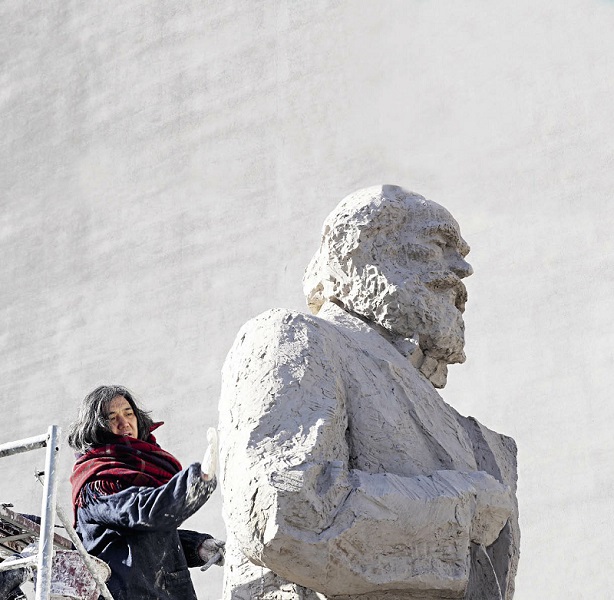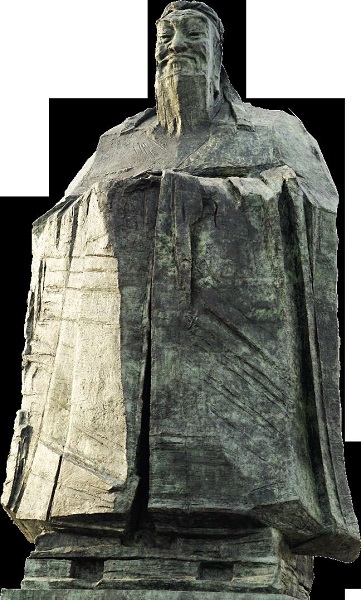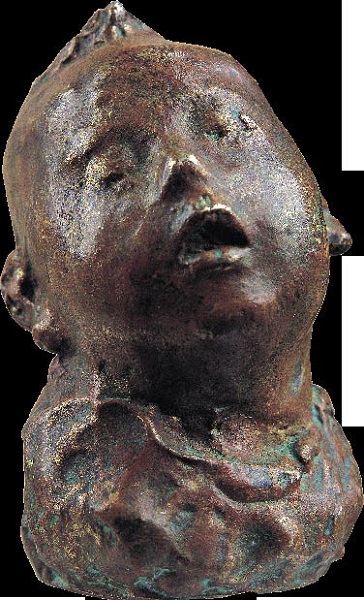
Wu Weishan is giving final touches to his statue of Karl Marx on November 21, 2017.
Statues Made for Our Era
Wu Weishan was born in January 1962 into a scholarly family in Shiyan Town, Dongtai County of east China’s Jiangsu Province. Around the age of six, he showed great interest in paintings on ceramic vessels and illustrations in old books found in his family collection.
In 1979, Wu was admitted to the local Wuxi School of Fine Arts, where he was fascinated by statues of Venus de Milo, Voltaire, and the bust of Michelangelo. Over the following two years, Wu learned clay sculpture from Gao Biao, a skilled craftsman in this field, attended lectures by renowned artists such as Wu Guanzhong and Qian Shaowu, and learned to sketch under the guidance of Wu Kaicheng, which laid a solid foundation for his overall cognition of art.
In 1991, at the age of 29, when Wu was director of the sculpture department at Nanjing Normal University, he was invited by Lin Changwu, the eldest son of Lin Sanzhi, a contemporary Chinese Caoshu calligraphy (featuring characters drawn swiftly and strokes that flow together) master, to make a bust of his father to be placed in his memorial hall.
When Wu finished the bust, the son exclaimed excitedly, “My father is alive!” This inspired Wu, and since then he has embarked on making statues for Chinese cultural celebrities.
Another incident made him even more determined to devote himself to this field. He still vividly remembers the story of a group of young people who went to pick up a pop star at Nanjing airport in the 1990s. Someone told them that Yang Zhenning, the world-renowned theoretical physicist, was also on the same flight. These young people were totally unaware of who Yang was and asked what songs he sang.
Wu was startled by their ignorance and decided it was important to make statues of great Chinese thinkers, scientists, writers, politicians, and artists who were all but forgotten by the younger generation. “I hope my statues can provide a cultural feast for our people to embrace, can help them feel the greatness of our giants, and remember the roads we have taken to make us what we are now,” he said.
Since 1994, Wu has created dozens of statues of Confucius in various shapes. The largest one is more than 20 meters high, and the smallest is 70 centimeters high. They now stand in many important cultural and educational sites around the world. He has also finished nearly 400 statues of Chinese historical and cultural celebrities. China Central Television (CCTV) once interviewed Wu and called him “statue maker for our era.”
With a strong sense of mission, Wu hoped that through his works, the historical figures such as Laozi and Confucius would be more recognizable to future generations, and would be perpetuated in human history.
Among all the masterpieces he has made, the prize-winning statue of Laozi is particularly popular. The statue is magnificent in shape and vivid in form, with Laozi bowing slightly and his body is engraved with the contents of the Chinese classic text Tao Te Ching. The image of a humble ancient Chinese philosopher full of thought is vividly presented.
In 2014, former French Prime Minister Dominique de Villepin spoke highly of Wu’s statue of Laozi, saying that China is expressed in this work.

The bronze statue of Confucius, the most influential ancient philosopher in China, by Wu Weishan.
Art Is a Translation
“In a globalized world and blessed with the current all-embracing art ecosystem, Chinese artists need to find a fulcrum to keep a balance between China’s classic art and contemporary global art. In this way, our fine arts could be well-positioned in the art history of the world,” said Wu. Based on such considerations, he put forward the concept of “freehand sculpture.”
“China’s freehand brushwork art is derived from astronomical as well as geographical images. It inherits the ancient Chinese philosophy of the unity of man and nature, and narrates and carries forward the poetic pursuit of an ancient yet new nation,” said Wu.
He believes that art itself is also a kind of translation, a translation of the objective and material world into subjective consciousness. Once when Wu was traveling in Venice, he imagined a scene where representations from the West and the East transcend time and space and sail together along the long river of human civilization. With this idea in mind, he later created the set of two large bronze sculptures “Beyond time and space – dialogue between Qi Baishi and Da Vinci” depicting the two famous painters.
On January 17, 2020, the sculpture was unveiled in the town of Vinci, Italy, which is the first time that the work of a Chinese sculptor has ever been displayed in Da Vinci’s birthplace.
In Wu’s eyes, translation also refers to mutual learning and the exchanges between civilizations, and the formation of new trends, as well as new artistic values and atmosphere in the dialogue between East and West. “For example, I like Rodin, Michelangelo, ancient Greek sculpture, as well as Western modernist works,” said Wu. “But just as bread and milk are different from our steamed bun and soybean juice, we need to ponder and explore how to better combine the Western and Chinese arts.”
“Professor Wu Weishan’s art shows us how an oriental artist expresses the world and human beings in the form of figurative art and modern visual art, and how great souls are cast in clay and bronze,” said Geraldo Lo Russo, former president of the Academy of Fine Arts of Rome.

The award-winning “Sleepy Kid” by Wu Weishan.
Telling Chinese Stories with Classics
“From ancient times to the present day, there are so many memorable people and stories of our land. We should grasp opportunities to tell the world our stories, and in my view, the essence of our culture, such as classical stories, is the first choice,” said Wu. He believes that cultural confidence comes first from a deep understanding of the important traditions of one’s own nation, especially a nation’s aesthetics.
In his opinion, the spiritual edifice of the Chinese nation is constructed by a large number of profound and exquisite literary and artistic works which have a solid base, bones, integrity, and love. Therefore, it is important to create good works with the Chinese spirit and introduce them to people all over the world.
Wu believes that the key to communication lies in dialogue and storytelling. Setting up statues and arranging exhibitions are good ways to get the message across.
According to Wu, statues of Chinese saints and sages should first be erected internationally as he feels that when such statues of a smiling and humble Laozi and Confucius are seen by people across the world, it will create the impression that China, with such ancestors, must be a nation of etiquette.
In addition to this, through the exhibition of ancient and modern works in the same tradition, a complete display of the beauty of the Chinese nation will also be seen, which will show the world the pace of progress of the Chinese nation, said Wu.
Yang Zhenning once said, “For more than 2,000 years, by following the teachings of Confucius, the Chinese nation has created the world’s longest, most populous, and most tenacious and harmonious cultural tradition. That’s why the Chinese respect Confucius as the supreme sage. Today, at the beginning of the great rejuvenation of the Chinese cultural tradition, we need to erect a statue that can show the spirit of Confucius. The giant statue of Confucius at the National Museum of China, with quiet seriousness, is the best way, in my view, to show that this supreme master is still standing among us today and teaching us the meaning of benevolence, righteousness, loyalty and respect of our elders.”
It is worth mentioning that this statue of Confucius, as Wu’s representative work, has been exhibited in the Fitzwilliam Museum in Cambridge, England as well as in important museums, art galleries and art institutions in Korea, Italy, Belgium, France, Singapore, among other countries.
On September 4, 2012, the then UN Secretary-General Ban Ki-moon, with his hand on the statue of Confucius (being exhibited along with other works by Wu), delivered a speech to diplomats from more than 100 countries around the world at the UN, saying that the works show not only the soul of a country, but also the soul of all mankind.
In September 2017, at the invitation of Rafael Greca, Mayor of Curitiba, Brazil, the Confucius statue was erected in Brazil. The sculpture base is 1.5 meters high and the overall height is 4.46 meters. It is cast in bronze and sits north facing south. It is a testament to the friendship between the Chinese and Brazilian people and an enduring symbol of the cultural exchange between China and Brazil. As the statue of Confucius is on permanent display, the Brazilian square is now called China Square, once again indicating how art can communicate the essence of a nation.








